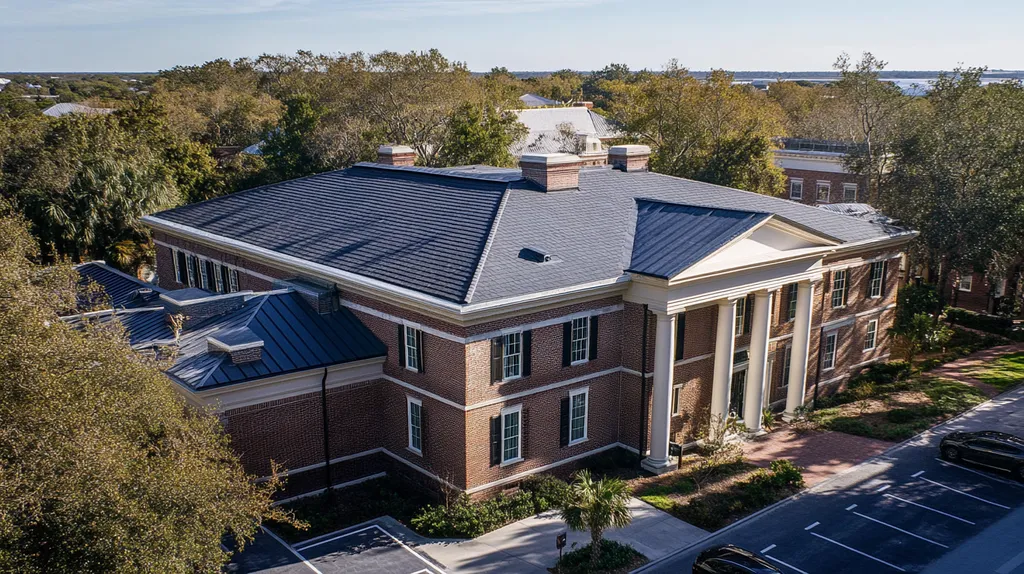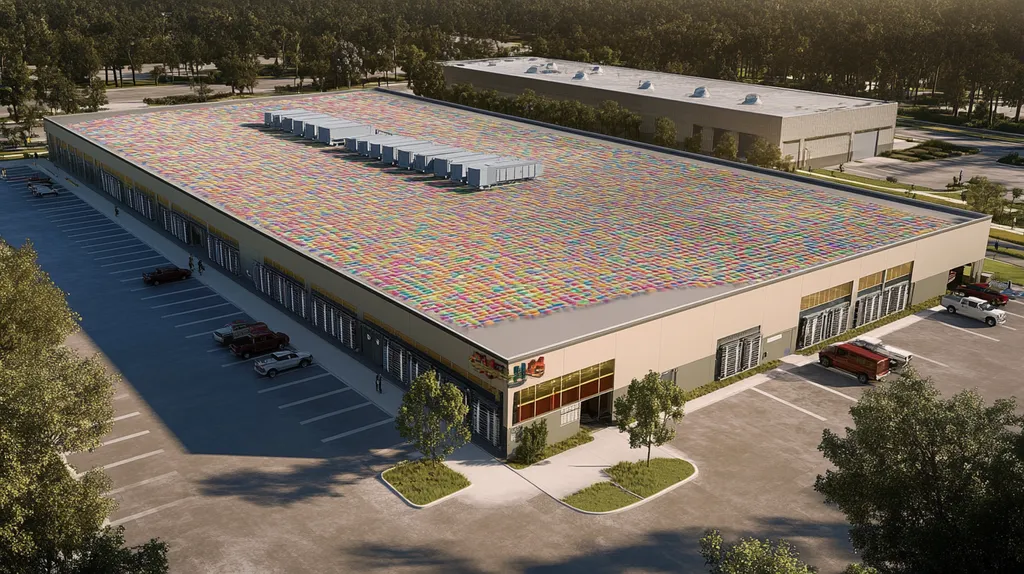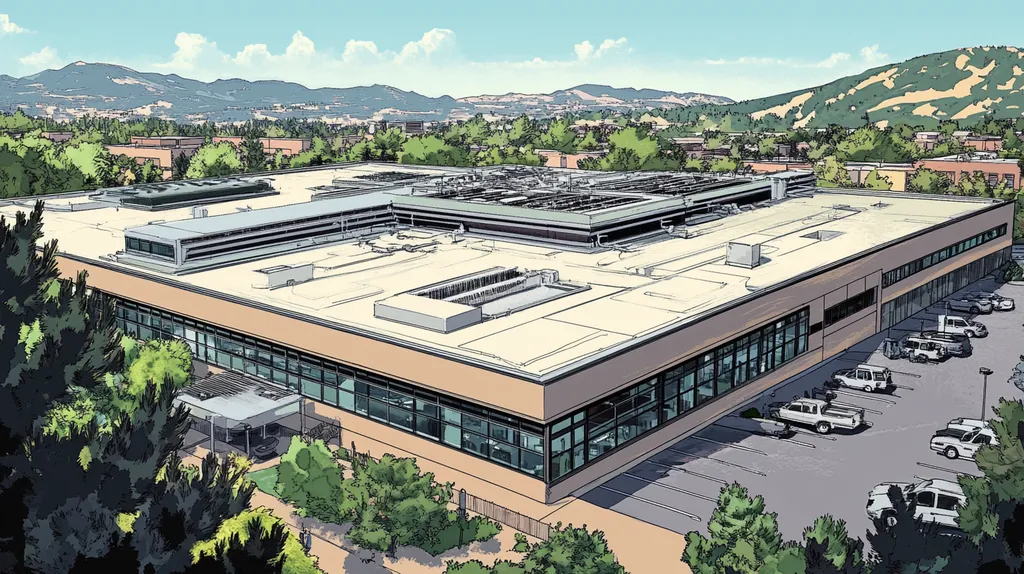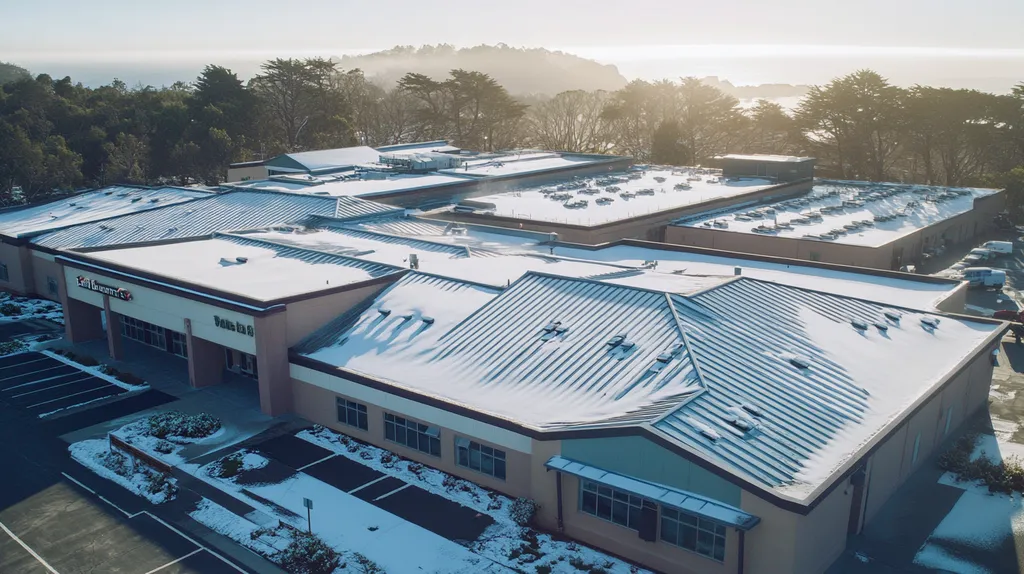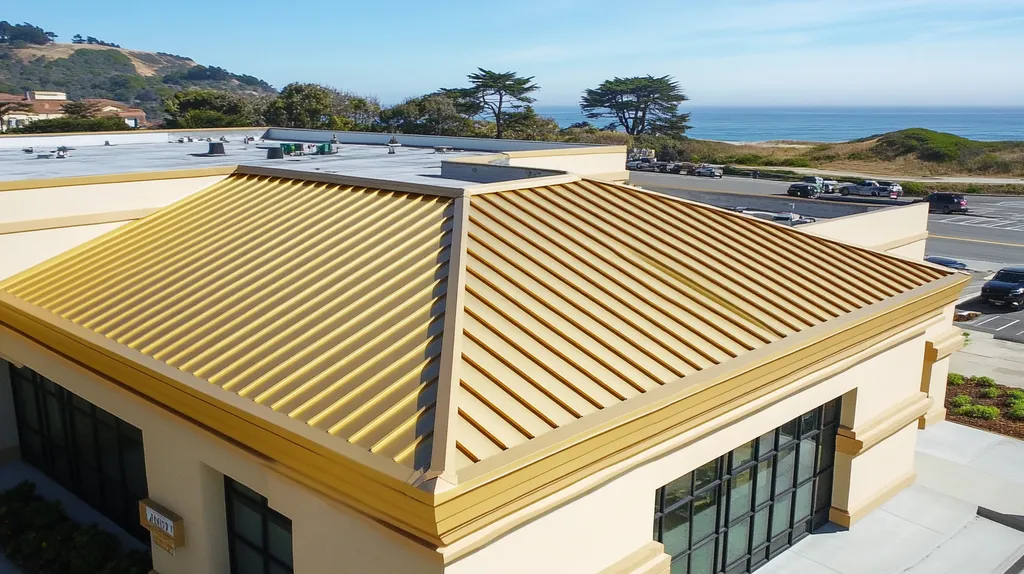Rising energy costs are forcing commercial property owners to scrutinize every aspect of their buildings’ efficiency. Research shows that poorly optimized roof reflectivity can increase cooling costs by up to 25% in warm climates.
For a typical 50,000-square-foot commercial building, this translates to thousands in unnecessary annual expenses. Recent studies indicate that enhancing roof reflectivity could reduce peak cooling demand by up to 15%.
This comprehensive guide examines critical factors in roof reflectivity optimization, from material selection and performance metrics to financial considerations and compliance requirements. Property professionals will discover actionable strategies to evaluate, implement, and maintain reflective roofing solutions that deliver measurable energy savings.
SECTION 1: PERFORMANCE FACTORS
The energy efficiency of a commercial building hinges significantly on its roof. Poor roofing performance can lead to soaring energy costs, especially in hotter regions where cooling demands are at their peak. Research indicates that as much as 20% of a facility’s total energy consumption can be linked to its roofing system. Understanding roof reflectivity and its impact on energy expenses is essential for property owners and managers aiming to make informed, cost-effective decisions.
Surface Reflectivity and Solar Reflectance Index
Surface reflectivity quantifies how effectively a roof reflects solar energy, measured using the Solar Reflectance Index (SRI). This index combines both solar reflectance and thermal emissivity, with higher values indicating lower heat absorption. For example, a roof with an SRI of 90 can keep indoor temperatures much cooler than one with an SRI of 20, demonstrating the measurable impact of reflectivity on energy use.
Property owners often overlook SRI when selecting roofing materials. Choosing options with lower reflectivity can lead to higher air conditioning needs, straining budgets and potentially shortening the lifespan of HVAC systems.
Additionally, albedo is a metric that illustrates how different roof colors and materials affect energy consumption. Lighter-colored roofs typically outperform darker ones, making them the preferred choice for energy-minded property managers.
Key Action Items
Material Composition and Coating Durability
The choice of materials in a roofing system is crucial to its overall performance. Popular options like metal, TPO, and EPDM are favored for their high reflectivity and long-lasting durability. Selecting high-quality coatings can enhance reflectivity over time, contributing to improved energy efficiency. Effective coatings also help protect against UV damage and other environmental wear.
Property managers should be aware that opting for a high-quality reflective roof can result in up to a 30% reduction in cooling costs. However, the durability of these materials plays an equally significant role, as a roof that degrades quickly can lead to increased maintenance costs and diminished energy efficiency.
Regular maintenance and inspections are critical for extending the life and effectiveness of roofing materials. These proactive measures enable property managers to identify and address issues early, ensuring that the roof maintains optimal performance.
Key Action Items
Thermal Emissivity and Heat Release Rates
Thermal emissivity measures how effectively a material releases absorbed heat. It works in tandem with reflectivity to influence a roof’s interaction with solar energy. A roofing material with high thermal emissivity can quickly shed heat, helping to keep indoor temperatures lower throughout the day and ultimately managing energy costs more effectively.
For instance, a roof that boasts both high reflectivity and high thermal emissivity will maintain more comfortable temperatures than one with low ratings. This balance reduces dependence on air conditioning systems, resulting in significant savings on energy bills.
When evaluating thermal emissivity, property owners must consider their local climate. In hotter regions, roofs that excel in reflectivity and emissivity offer substantial advantages. Conversely, in colder climates, it might be more beneficial to focus on roofs that retain heat during winter months.
Key Action Items
SECTION 2: FINANCIAL CONSIDERATIONS
The financial ramifications of roof reflectivity can significantly affect the budgets of commercial and industrial property owners. Energy costs often consume a large portion of operational expenses, particularly in warmer climates where air conditioning is vital. According to the U.S. Department of Energy, reflective roofing can cut cooling costs by up to 30%. This section will delve into energy savings, return on investment (ROI) from reflective upgrades, and the potential for utility rebates and incentive programs that can further ease financial burdens.
Energy Cost Savings from Cooling Load Reduction
When it comes to cooling costs, the benefits of reflective roofing cannot be overstated. Traditional dark or non-reflective roofs soak up heat, making HVAC systems work harder and run longer. In contrast, reflective roofs bounce sunlight away, keeping indoor temperatures cooler and easing the demand on air conditioning units.
For instance, a building with a dark flat roof in sunny regions could save thousands each year by switching to a reflective membrane. Each degree of temperature reduction directly translates to lower cooling bills, which makes the case for investing in reflective options even more compelling as energy costs continue to rise.
Additionally, lowering the energy load does more than just save money; it also enhances the lifespan of HVAC systems. Less demand translates to fewer repairs and replacements, offering even more financial benefits. This interplay between roofing choices and energy efficiency underscores why it’s essential for property professionals to prioritize the reflectivity of their roofs.
Key Action Items
Return on Investment from Reflective Roof Upgrades
The ROI for reflective roof upgrades is often swift and measurable. While the upfront costs of upgrading can raise initial concerns, the long-term savings frequently outweigh these expenses. In fact, many property owners find they can recoup their investments within 3-5 years thanks to lower energy bills.
For example, buildings that shift to highly reflective materials can see energy savings of nearly 50% during peak summer months. Financial modeling can illuminate these potential savings and facilitate securing funding or buy-in for necessary enhancements.
Moreover, energy-efficient features like reflective roofs can elevate property values as they become increasingly attractive to tenants. With a growing focus on sustainability, investing in reflective roofing may help in attracting and retaining occupants who prioritize energy-efficient locations.
Key Action Items
Utility Rebate Eligibility and Incentive Programs
Many utility companies and government entities provide rebates and incentives for property owners who invest in energy-efficient upgrades, including reflective roofing. Such initiatives can make the transition to a reflective roof more financially viable.
For instance, certain states offer tax credits or direct rebates for switching to white or reflective roofing materials. These incentives can cover anywhere from 20% to 40% of the initial costs, drastically improving the project’s financial feasibility.
Engaging with local utility providers may uncover programs specifically designed to encourage energy efficiency. Conducting an energy audit often reveals various financial incentives related to roof reflectivity that can be utilized.
By taking advantage of these opportunities, property owners not only lower their initial costs but also promote sustainable practices within their organizations. In an era that increasingly values corporate responsibility, leveraging these incentives represents a smart financial strategy.
Key Action Items
SECTION 3: COMPLIANCE REQUIREMENTS
Compliance with roofing reflectivity standards is vital for property owners and facility managers. Failure to meet these requirements can increase energy costs and lead to potential legal issues, such as fines or expensive retrofits. By understanding and adhering to compliance standards, property professionals can not only enhance sustainability but also protect their financial interests.
Cool Roof Rating Council (CRRC) Certification Standards
The Cool Roof Rating Council (CRRC) sets crucial certification standards for roofing materials. These standards evaluate how effectively materials reflect solar energy and release heat. Buildings equipped with CRRC-certified roofs can lower cooling energy expenses by as much as 20%.
Property owners should seek to install roofs that meet or surpass these certification standards. This proactive approach helps reduce energy costs while enhancing marketability. Additionally, compliance with CRRC standards is often necessary for meeting state energy codes, making familiarity with these standards essential.
By choosing CRRC-certified materials, property managers can ensure long-term compliance and operational savings, avoiding unnecessary financial strain due to unexpected costs and regulatory issues.
Key Action Items
State-Specific Energy Code Adherence
In addition to national guidelines, compliance with state-specific energy codes is crucial for commercial properties. These regulations vary by state and often include specific reflectivity requirements for roofs. Non-compliance may lead to fines, project delays, or costly modifications.
For example, some states mandate a minimum solar reflectance index (SRI) for new roofs. It’s essential to stay informed about these local requirements to avoid oversights, especially when dealing with permits and inspections.
Ensuring adherence not only helps avoid penalties but also enhances property appeal, as compliant roofs can qualify for tax benefits or utility rebates, directly benefiting energy costs.
Key Action Items
Green Building Program Alignment (LEED, ENERGY STAR)
Aligning roofing projects with well-known green building programs like LEED and ENERGY STAR can yield significant benefits for property owners. Certifications encourage sustainable construction practices and can enhance overall building value. These programs generally require stringent roof reflectivity and energy efficiency standards.
For instance, the LEED program awards points for using materials with high solar reflectance, making compliance essential for achieving certification. This recognition can attract environmentally conscious tenants and elevate the property’s status in the market.
Additionally, participating in ENERGY STAR programs can offer advantages such as utility rebates and recognition, fostering a commitment to reduce environmental impact and improve energy efficiency over the long term.
Key Action Items
SECTION 4: RISK MANAGEMENT
Effective risk management is essential for property professionals focused on enhancing roof reflectivity while managing energy costs. Ignoring these risks can lead to unplanned expenses and inefficiencies. For instance, buildings lacking sufficient reflectivity may experience significant spikes in energy bills during peak demand periods, adversely affecting overall budgets. Addressing these risks with proactive strategies is not just wise but necessary for financial health.
Peak Demand Charge Mitigation Strategies
Peak demand charges can significantly inflate energy bills for commercial properties, especially during hot weather when cooling needs surge. Improving roof reflectivity can drastically reduce heat absorption, resulting in lower cooling loads and less strain on HVAC systems during peak hours.
For example, switching to white or light-colored roofing materials can lower rooftop temperatures by up to 30°F compared to traditional dark roofs. This reduction translates into substantial energy savings, positively impacting the bottom line.
Integrating smart energy management systems can enhance this approach by optimizing HVAC performance, ensuring efficient operation during peak demand, and avoiding additional charges. This combination of strategies allows property owners to effectively manage unpredictable energy costs.
Key Action Items
Warranty Compliance for Reflective Surface Maintenance
Adhering to warranty requirements is crucial for maintaining reflective roofing surfaces. Many warranties have specific maintenance stipulations, and neglecting these can void coverage, leading to costly repairs.
Regular inspections and cleaning are essential for retaining roof performance and reflectivity. Accumulated debris can hinder effectiveness and raise energy costs, making a comprehensive maintenance plan vital for protecting investments.
Engaging directly with manufacturers regarding maintenance procedures ensures clarity on warranty terms and showcases commitment to upholding the roof’s reflective qualities, enhancing appeal to potential tenants.
Key Action Items
Thermal Stress and Material Degradation Prevention
The risk of thermal stress is often overlooked in roofing systems. Temperature fluctuations lead to expansion and contraction, potentially degrading materials over time. Failing to address this can compromise roof integrity and reflectivity.
To mitigate thermal stress, property managers should select materials designed for high reflectivity and durability. These materials are less likely to warp or crack, ensuring a longer lifespan and lower costs.
Additionally, ensuring adequate ventilation within the roofing system moderates temperature extremes, further minimizing thermal stress. Regular maintenance checks should assess ventilation systems as part of a thorough thermal management plan.
Key Action Items
SECTION 5: OPERATIONAL PROCEDURES
As energy costs continue to rise and environmental awareness grows, the reflectivity of commercial roofs is an increasingly pressing concern. Property owners and facility managers must prioritize operational procedures that enhance a roof’s energy efficiency. By adopting effective protocols, businesses can lower costs, improve overall building performance, and extend the lifespan of their roofs—ultimately increasing tenant comfort. This section provides vital operational practices for assessing, applying, and verifying roof reflectivity to achieve superior energy performance.
Pre-Installation Reflectivity Assessment Protocols
A comprehensive pre-installation reflectivity assessment is essential for optimizing energy efficiency. Property professionals should begin by reviewing the existing roof materials, noting their current reflectivity levels, which can be measured using a reflectometer.
Additionally, environmental factors significantly influence material selection. For example, roofing materials that excel in sunny climates may not be as effective in overcast areas, making climate awareness crucial.
Consulting with roofing experts can assist in matching specific coatings to energy efficiency goals. Setting clear benchmarks during assessments establishes expectations for post-installation performance, ensuring long-lasting benefits and compliance with energy efficiency standards.
Key Action Items
Coating Application Quality Control Measures
Ensuring maximum effectiveness of reflective coatings requires strict quality control during application. Proper surface preparation is crucial; the roof must be clean, dry, and devoid of contaminants that could impede adhesion.
Coatings should be applied by trained professionals in accordance with manufacturer specifications. Deviations from these guidelines can lead to uneven coverage and reduced reflectivity.
Conducting routine inspections during the application helps identify potential issues early, while documenting the process provides valuable data for any future assessments or troubleshooting.
Key Action Items
Post-Installation Performance Verification Testing
After installation, verifying the roof’s performance is vital to ensure it meets reflectivity standards. Conducting post-installation testing measures actual reflectivity levels achieved after coating application.
An ongoing performance evaluation should be integrated into the maintenance schedule, allowing property managers to spot potential problems that could affect energy efficiency over time.
Employing technologies such as infrared thermography can help identify hotspots that indicate insufficient reflectivity, enabling targeted maintenance actions to preserve the roof’s energy-saving capabilities.
Key Action Items
SECTION 5: OPERATIONAL PROCEDURES
As energy costs escalate and awareness of environmental issues grows, the reflectivity of commercial roofs has become increasingly important. Property owners and facility managers must recognize how their operational procedures can drastically improve a roof’s energy efficiency. Implementing effective protocols not only reduces costs but also enhances building performance, prolongs roof lifespan, and increases tenant comfort. This section outlines essential practices for assessing, applying, and verifying roof reflectivity to achieve optimal energy performance.
Pre-Installation Reflectivity Assessment Protocols
A thorough pre-installation reflectivity assessment is crucial for maximizing energy efficiency. Property professionals should begin by analyzing the existing roof materials, measuring current reflectivity levels using a reflectometer.
Environmental factors play a significant role in material selection. For example, a roofing material that performs well in sunny regions may not be effective in cloudier climates. Understanding the local climate is essential for choosing optimal reflective materials.
Consulting roofing experts can provide insight into matching coatings with energy efficiency goals. Establishing clear benchmarks during the assessment sets expectations for post-installation performance and ensures longevity of the roofing system.
Key Action Items
Coating Application Quality Control Measures
The application of reflective coatings requires stringent quality control to ensure maximum effectiveness. First, proper surface preparation is essential; the roof must be clean, dry, and free from contaminants that can hinder adhesion.
Coatings must be applied by trained professionals following manufacturer specifications. Deviating from these guidelines can lead to uneven coverage, which compromises overall reflectivity.
Routine inspections during the application process are vital for identifying potential problems early. It’s important to monitor coating thickness and uniformity to ensure the best possible outcome.
Key Action Items
Post-Installation Performance Verification Testing
After installation, verifying the roof’s performance is crucial to ensure it meets reflectivity standards. This process involves conducting tests to measure the actual reflectivity levels achieved after coating application.
Regular performance evaluations should be part of the maintenance schedule. Ongoing assessments help property managers identify issues that may risk energy efficiency over time.
Utilizing infrared thermography can detect hotspots that indicate insufficient reflectivity, enabling timely maintenance actions that preserve the roof’s energy-saving capabilities.
Key Action Items
The Bottom Line
With energy costs rising 5-7% annually, commercial property owners can no longer afford to overlook roof reflectivity as a critical factor in building efficiency.
Studies show that buildings with optimized reflective roofing systems reduce cooling costs by 25-30% on average, translating to tens of thousands in annual savings for typical commercial properties.
The technology and materials exist today to dramatically improve roof performance, yet many facilities continue operating with outdated, inefficient roofing systems.
By implementing the strategies outlined in this guide, property professionals can significantly reduce energy expenses while ensuring compliance with evolving regulations and sustainability standards.
With proper planning and execution, reflective roofing upgrades represent one of the most impactful investments available for improving a building’s long-term operational efficiency.
FREQUENTLY ASKED QUESTIONS
Q. How does the reflectivity of a commercial roof affect energy costs?
A. The reflectivity of a roof significantly influences energy efficiency. Higher reflectivity can lead to lower cooling costs, reducing the HVAC load in warmer climates by reflecting more sunlight away, thus keeping indoor temperatures cooler.
Q. What should I consider for industrial roof upgrades?
A. When upgrading an industrial roof, consider material reflectivity, durability, and local climate. Investing in high-quality reflective materials can optimize energy efficiency while prolonging the roof’s lifespan.
Q. Why is the Solar Reflectance Index (SRI) important for roofing?
A. The Solar Reflectance Index is vital as it measures a roof’s ability to reflect heat. A high SRI rating indicates better performance in reducing heat absorption, which can lead to cost savings on cooling expenses.
Q. How can I assess energy savings from reflective roofing?
A. To assess energy savings, compare energy usage data before and after installation of reflective roofing. Document cooling costs and monitor HVAC performance to gauge improvements directly related to the roof’s reflectivity.
Q. What are the regulatory requirements for roof reflectivity?
A. Regulatory requirements can vary by state but generally include compliance with reflectivity standards such as those set by the Cool Roof Rating Council. Familiarizing yourself with local codes is essential to avoid penalties and ensure compliance.
Q. How do I maintain my commercial roof’s reflectivity?
A. Maintain reflectivity by performing regular inspections and cleaning. Ensure the roof surface remains free of debris, which can impede reflectivity, and follow your warranty’s maintenance guidelines to protect your investment.
Q. What additional benefits do reflective roofs provide?
A. Reflective roofs contribute to improved indoor comfort and may qualify buildings for energy-efficiency certifications. Additionally, they can enhance property marketability and lead to potential energy rebates from utility companies.

